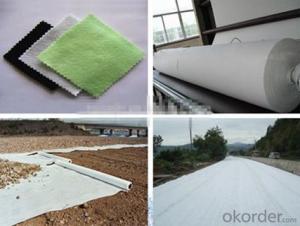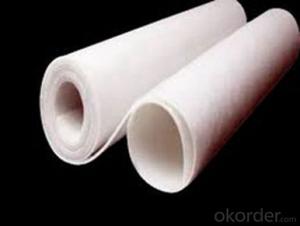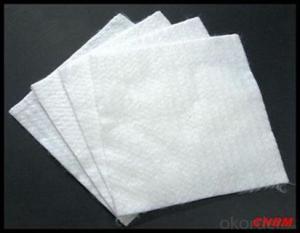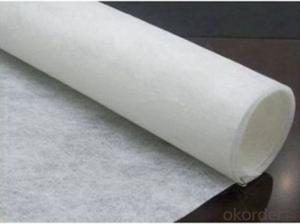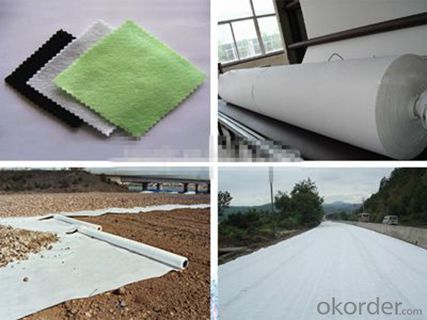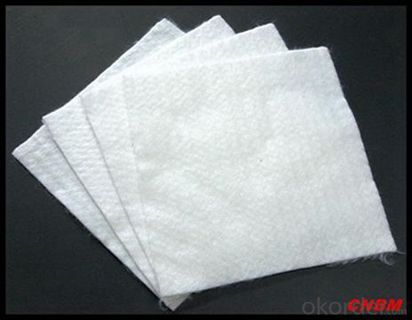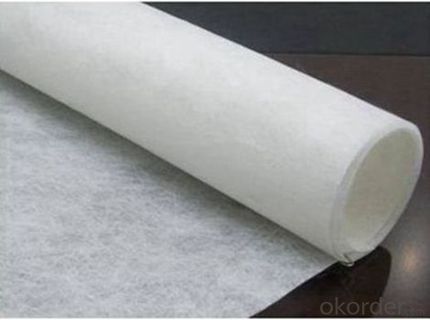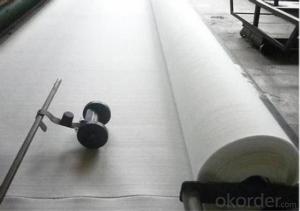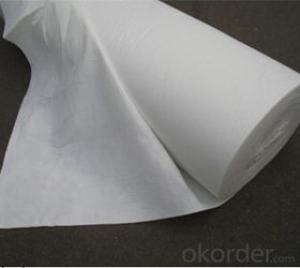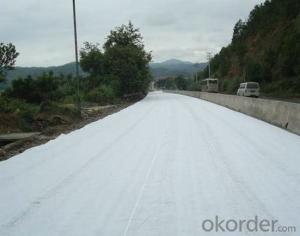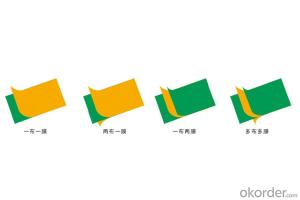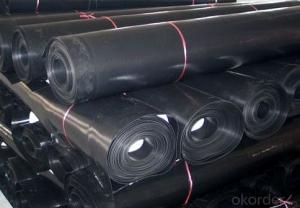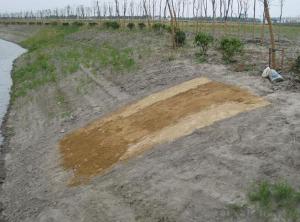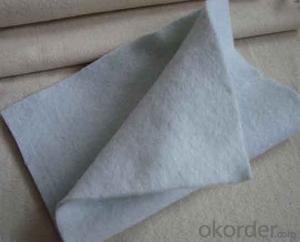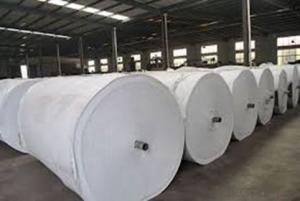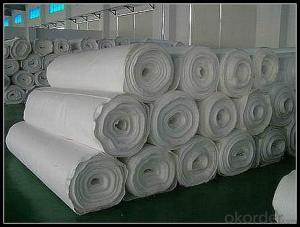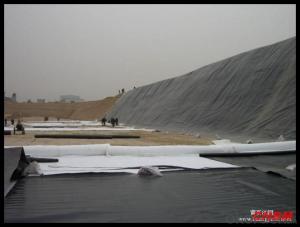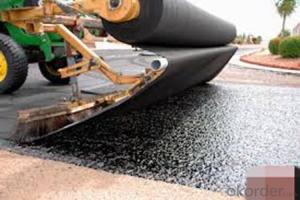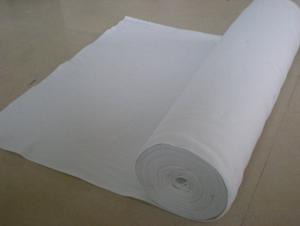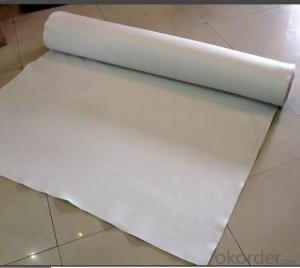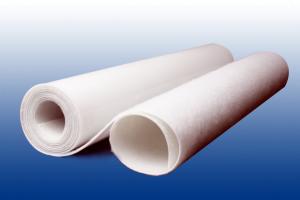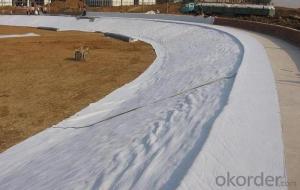PP Non-Woven and Woven Geotextile Fabric for Railway Construction Companies
- Loading Port:
- China main port
- Payment Terms:
- TT OR LC
- Min Order Qty:
- 4000 m²
- Supply Capability:
- 1000000 m²/month
OKorder Service Pledge
OKorder Financial Service
You Might Also Like
Specification
Geotextile fabric Use:
used in irrigation, dams, roads, airports, construction, environmental engineering, you can play a filtration, drainage, separation, protection, reinforcement effect.
Geotextiles, also known as geotextile fabric, which is made of synthetic fibers woven acupuncture or permeable geosynthetics through. Finished as the cloth-like, generally a width of 4-6m, length of 50-100m. Geotextile into woven geotextiles and non-woven geotextile. Geotextile with excellent filtration, drainage, separation, reinforcement, seepage, protective effect, with a light weight, high tensile strength, good permeability, high temperature, anti-freeze, anti-aging, corrosion
Advantages
1) Isolation
The use of geotextile different physical properties (particle size, distribution, density and thickness, etc.) materials (such as soil and sand and gravel soil, soil and concrete, etc.) for isolation. So that two or more materials are not loss of inter-and non hybrid,to maintain the overall structure of the material and functions of the structures is to strengthen the load bearing capacity.
2) Filter
When the water from fine materials into the soil layers of rough material, the use of acupuncture geogextile good air and water permeability, so that the water flow through, and effective interception soil particles, spinning, the small stone so as to maintain the stability of the soil and water projects.
3) Drainage
Acupuncture geotextile is a good hydraulic material, which can from a soil internal drainage channel, soil structure and excess liquid gas emissions.
4) Reinforced
Acupuncture use of geotextile to enhance soil and the tensile strength of the antideformation ability to increase the stability of the building structure in order to improve the quality of the soil.
5) Protection
Will focus on effective stress-proliferation, transfer or broken down by external force to prevent the soil and damage.
6) Closed
Acupuncture geotextile and other materials (primarily asphalt or plastic film) with the formation of impermeable layer of insulation layer. (Mainly used for road resurfacing and repairing, etc.)
Photos:
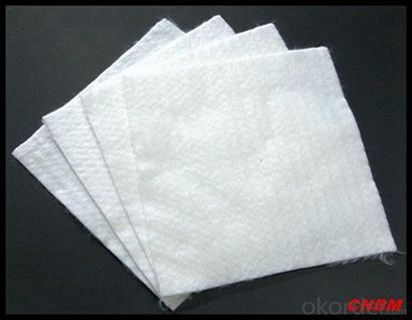
Packaging & Shipping
Packing: PLASTIC FILM INSIDE, AND WOVEN BAG OUTSIDE
Shipping: About 15 days after receipt the deposit
geotextile fabric
permeability,filtration,easy for construction
ISO and CE certificate
Good quality and competitive price
Our Service
Quality assurance
1.On a regular basis or as per your request,we entrust national testing agencies to conduct quality inspections
2. Strictly in accordance with the ISO9001-2008 international quality system standard,we monitor and manage the whole process throughout production,quality testing,and measurement to ensure product quality
3. For quality-related construction delay or substandard construction(except for damage or losses due to customer’s responsibility or irresistible natural disasters),we have refunding,replacement,and repair services.We will respond to customers’ feedbacks on quality issues within 24 hours.
After-sales service
1.In order to provide customers with comprehensive technical support,we will provide technical and other related information upon request in a timely manner.
2.In required,we will appoint specialized technicians to the construction site to give technical trainings to construction people,and offer technical guidance throughout the whole construction process.
3.For damage due to shipment and delivery,after we receive the complaint,we will check the issure through provided pictures and videos.If our responsibility is confirmed,we wil offer free replacement.
4.When the construction is completed,as your request,our technical staff may participate in the final acceptance.
FAQ:
Q: What kind of payments does jenor support?
A: T/T, L/C, Cash are accepted.
Q: Do you charge for the samples?
A: Accordeing to our company policy, the samples are free, we only charge the freight fee. And we will return the freight fee during the next order.
Q: Can you produce according to customers' design?
A: Sure, we are professional manufacturer, OEM and ODM are both welcome.
Q: Do you have other products?
A: Yes, please check the pictures:
- Q: Can geotextiles be used for livestock waste management?
- Yes, geotextiles can be used for livestock waste management. They are commonly used as liners in lagoons or ponds to separate and contain livestock waste, preventing it from contaminating groundwater or nearby water bodies. Geotextiles can effectively filter and separate solid waste from liquid, allowing for proper waste management and reducing environmental impacts.
- Q: Are geotextiles suitable for use in gabion walls?
- Yes, geotextiles are suitable for use in gabion walls. They can be used as a filter fabric to prevent soil erosion and improve drainage within the gabion structure. Additionally, geotextiles help to separate different layers of materials, preventing mixing and maintaining the stability of the gabion wall.
- Q: What are the considerations for geotextile selection in shoreline erosion control?
- When selecting geotextiles for shoreline erosion control, several considerations need to be taken into account. These include the strength and durability of the geotextile, its resistance to UV degradation and chemical exposure, its permeability to allow for proper drainage, and its ability to retain sediment while still allowing for plant growth. Additionally, factors such as cost-effectiveness, installation requirements, and the specific environmental conditions of the shoreline should also be considered in the selection process.
- Q: What are the different methods of installing geotextiles?
- There are several methods of installing geotextiles, including direct placement, trench installation, and anchoring. Direct placement involves simply unrolling the geotextile fabric over the desired area and securing it with stakes or other means. Trench installation involves excavating a trench, placing the geotextile fabric in the trench, and backfilling it with soil or other materials. Anchoring is another method where the geotextile fabric is secured to the ground using anchors, such as pins or staples, to prevent movement or displacement.
- Q: What are the considerations for geotextile selection in landfill projects?
- When selecting geotextiles for landfill projects, several considerations must be taken into account. These include the desired function of the geotextile, such as separation, filtration, or drainage. The physical properties of the geotextile, such as tensile strength, puncture resistance, and thickness, are also important factors to consider. Additionally, the site conditions, such as soil type, water table, and potential for chemical exposure, should be evaluated to ensure the geotextile's compatibility. Lastly, the long-term durability and cost-effectiveness of the geotextile should be considered to ensure its suitability for the landfill project.
- Q: Do you have to have a mattress on the geotextile?
- 1, geotextile must be washed back to fill or sand protective layer and light compaction to prevent the subsequent construction of the destruction of geotextile, punctured and so on. But also a transition zone, to ease the upper load on the geotextile extrusion, tensile force and so on. 2, "Geotextile Construction Code QB / SNGSG-2004" and "Geosynthetics Application Technical Specifications GB / T-2017" backfill requirements: 1) timely backfill materials, backfill stone maximum drop of not more than 300mm, Heavy earth stones should not roll on the slope of the rolling; 2) fill the compaction should meet the design requirements, backfill 300mm loose layer, light compaction. 3, geotextile introduction: 1), geotextile by synthetic fiber through acupuncture or weaving made of permeable geosynthetics. Finished cloth for the cloth, the general width of 4-6 meters, the length of 50-100 meters. Geotextile is divided into a woven geotextile and non-woven geotextile. Advantages: geotextile with excellent filtration, drainage, isolation, reinforcement, anti-seepage, protection, with a light weight, high tensile strength, good permeability, high temperature, resistance to Freezing, anti-aging, corrosion-resistant advantages. 2), Disadvantages: in the rigid base waterproof requirements are not applicable (tensile rate does not meet the requirements), easy to break, scratches and so on.
- Q: Geotextile exports Nordic need certification
- Production standards geotextile, geomembrane, composite geomembrane. Certificate, test report
- Q: Can geotextiles be used for reinforcement of underground tunnels?
- Yes, geotextiles can be used for reinforcement of underground tunnels. Geotextiles are commonly used in civil engineering projects, including tunnel construction, to provide reinforcement, drainage, and separation. In the case of underground tunnels, geotextiles can be installed to prevent soil erosion, provide stability, and enhance the overall structural integrity of the tunnel.
- Q: 1 square of non-woven geotextiles how many tons
- Ask what you know is a person who has just started to focus on the profession. The quality of a square meter of non-woven geotextiles in general between tens of grams to more than 1000 grams.
- Q: How do geotextiles enhance drainage systems?
- Geotextiles enhance drainage systems by providing a filtration layer that allows water to pass through while preventing soil particles from clogging the system. They also improve the overall stability and longevity of the drainage system by preventing soil erosion and maintaining the integrity of the soil structure.
Send your message to us
PP Non-Woven and Woven Geotextile Fabric for Railway Construction Companies
- Loading Port:
- China main port
- Payment Terms:
- TT OR LC
- Min Order Qty:
- 4000 m²
- Supply Capability:
- 1000000 m²/month
OKorder Service Pledge
OKorder Financial Service
Similar products
Hot products
Hot Searches
Related keywords
